Person-Centred Adult Care: Implementation and Evaluation Report
VerifiedAdded on 2022/12/27
|9
|2748
|94
Report
AI Summary
This report provides a comprehensive overview of person-centred adult care, emphasizing outcome-based practices and their significance in healthcare settings. It explores the importance of various relationships in supporting a person-centred approach, highlighting how active participation enhances the well-being of service users. The report delves into the roles of legislation, regulations, and codes of conduct in achieving desired outcomes, along with the impact of integrated approaches in care delivery. It addresses leadership roles in implementing person-centred practices, promoting diversity, equality, and inclusion, and fostering continuous quality improvement within organizations. The report also examines the evaluation of changes made, the consideration of team views, the effectiveness of whistle-blowing procedures, and methods for collecting evidence of process effectiveness. Furthermore, it details procedures for reporting accidents, incidents, and near misses, and reviews relevant information used to reduce such occurrences, ensuring team awareness.
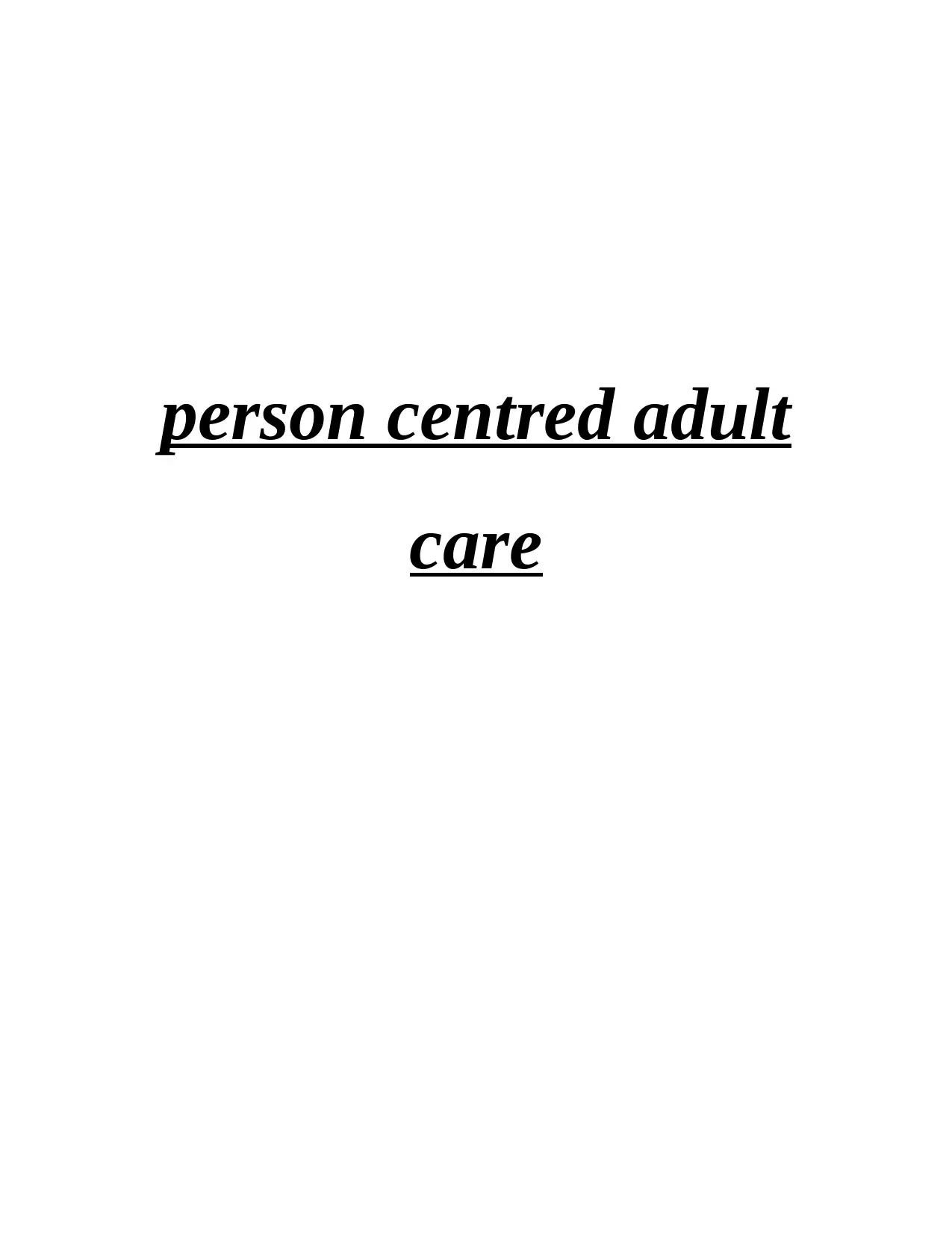
person centred adult
care
care
Paraphrase This Document
Need a fresh take? Get an instant paraphrase of this document with our AI Paraphraser
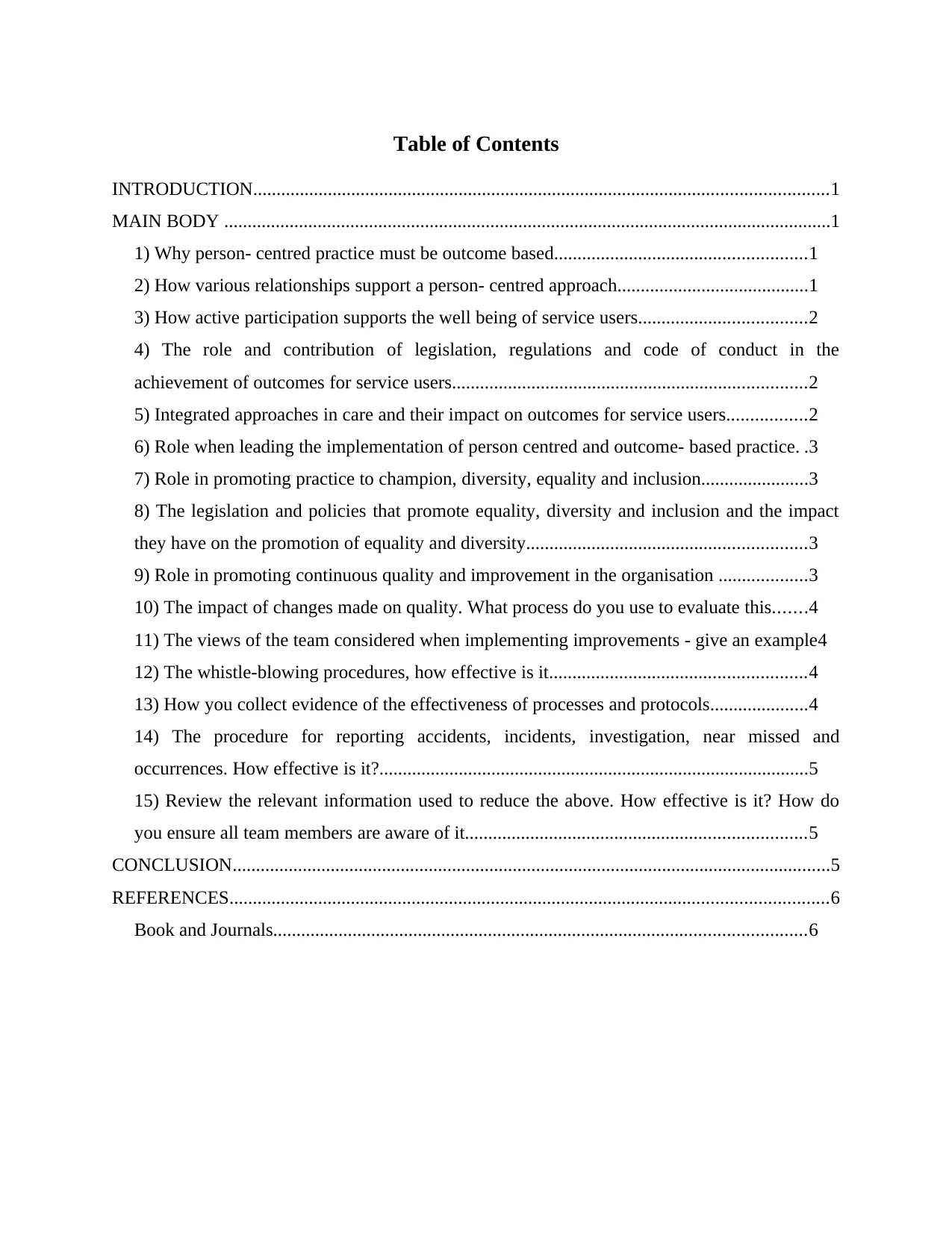
Table of Contents
INTRODUCTION...........................................................................................................................1
MAIN BODY ..................................................................................................................................1
1) Why person- centred practice must be outcome based......................................................1
2) How various relationships support a person- centred approach.........................................1
3) How active participation supports the well being of service users....................................2
4) The role and contribution of legislation, regulations and code of conduct in the
achievement of outcomes for service users............................................................................2
5) Integrated approaches in care and their impact on outcomes for service users.................2
6) Role when leading the implementation of person centred and outcome- based practice. .3
7) Role in promoting practice to champion, diversity, equality and inclusion.......................3
8) The legislation and policies that promote equality, diversity and inclusion and the impact
they have on the promotion of equality and diversity............................................................3
9) Role in promoting continuous quality and improvement in the organisation ...................3
10) The impact of changes made on quality. What process do you use to evaluate this.......4
11) The views of the team considered when implementing improvements - give an example4
12) The whistle-blowing procedures, how effective is it.......................................................4
13) How you collect evidence of the effectiveness of processes and protocols.....................4
14) The procedure for reporting accidents, incidents, investigation, near missed and
occurrences. How effective is it?............................................................................................5
15) Review the relevant information used to reduce the above. How effective is it? How do
you ensure all team members are aware of it.........................................................................5
CONCLUSION................................................................................................................................5
REFERENCES................................................................................................................................6
Book and Journals..................................................................................................................6
INTRODUCTION...........................................................................................................................1
MAIN BODY ..................................................................................................................................1
1) Why person- centred practice must be outcome based......................................................1
2) How various relationships support a person- centred approach.........................................1
3) How active participation supports the well being of service users....................................2
4) The role and contribution of legislation, regulations and code of conduct in the
achievement of outcomes for service users............................................................................2
5) Integrated approaches in care and their impact on outcomes for service users.................2
6) Role when leading the implementation of person centred and outcome- based practice. .3
7) Role in promoting practice to champion, diversity, equality and inclusion.......................3
8) The legislation and policies that promote equality, diversity and inclusion and the impact
they have on the promotion of equality and diversity............................................................3
9) Role in promoting continuous quality and improvement in the organisation ...................3
10) The impact of changes made on quality. What process do you use to evaluate this.......4
11) The views of the team considered when implementing improvements - give an example4
12) The whistle-blowing procedures, how effective is it.......................................................4
13) How you collect evidence of the effectiveness of processes and protocols.....................4
14) The procedure for reporting accidents, incidents, investigation, near missed and
occurrences. How effective is it?............................................................................................5
15) Review the relevant information used to reduce the above. How effective is it? How do
you ensure all team members are aware of it.........................................................................5
CONCLUSION................................................................................................................................5
REFERENCES................................................................................................................................6
Book and Journals..................................................................................................................6

⊘ This is a preview!⊘
Do you want full access?
Subscribe today to unlock all pages.

Trusted by 1+ million students worldwide
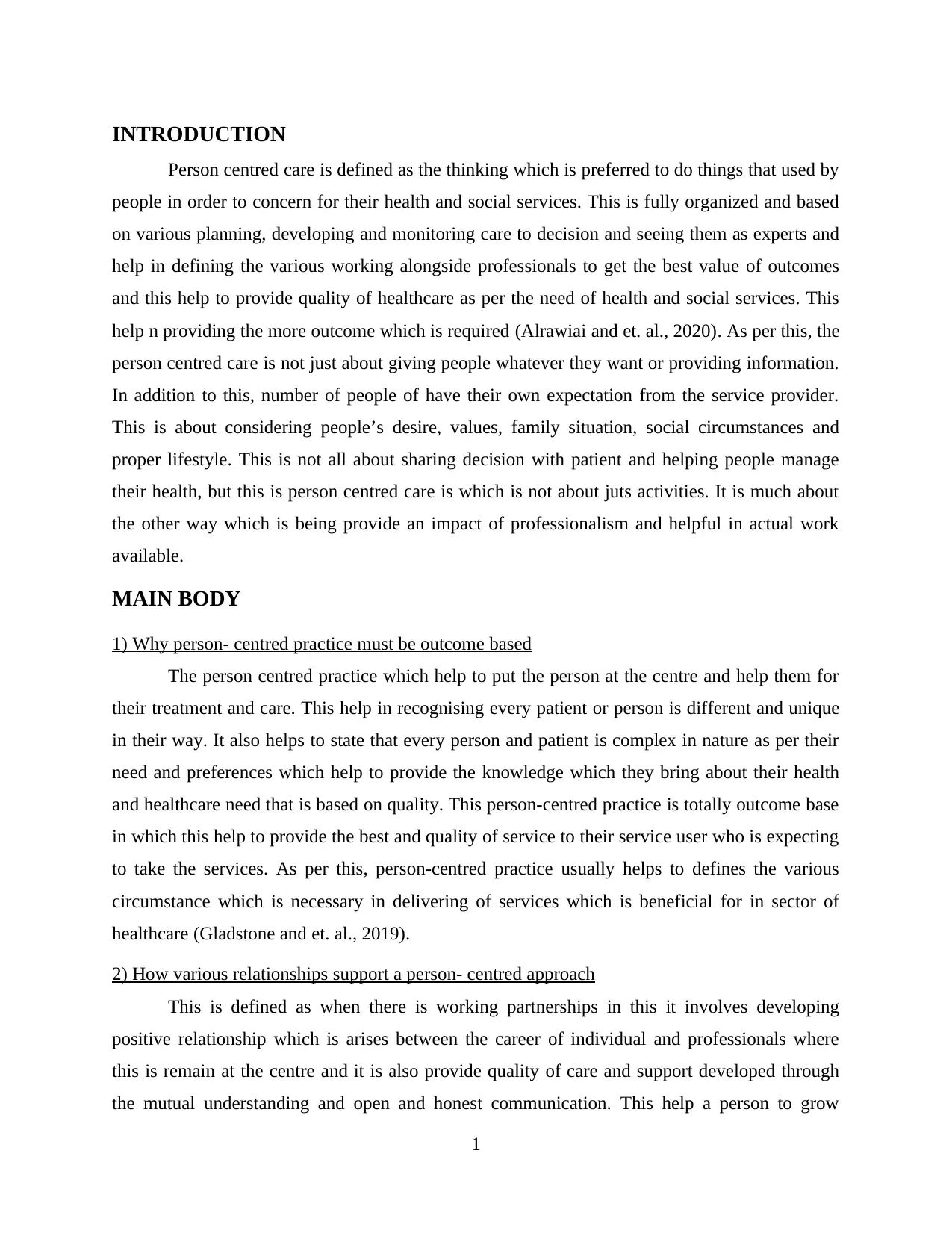
INTRODUCTION
Person centred care is defined as the thinking which is preferred to do things that used by
people in order to concern for their health and social services. This is fully organized and based
on various planning, developing and monitoring care to decision and seeing them as experts and
help in defining the various working alongside professionals to get the best value of outcomes
and this help to provide quality of healthcare as per the need of health and social services. This
help n providing the more outcome which is required (Alrawiai and et. al., 2020). As per this, the
person centred care is not just about giving people whatever they want or providing information.
In addition to this, number of people of have their own expectation from the service provider.
This is about considering people’s desire, values, family situation, social circumstances and
proper lifestyle. This is not all about sharing decision with patient and helping people manage
their health, but this is person centred care is which is not about juts activities. It is much about
the other way which is being provide an impact of professionalism and helpful in actual work
available.
MAIN BODY
1) Why person- centred practice must be outcome based
The person centred practice which help to put the person at the centre and help them for
their treatment and care. This help in recognising every patient or person is different and unique
in their way. It also helps to state that every person and patient is complex in nature as per their
need and preferences which help to provide the knowledge which they bring about their health
and healthcare need that is based on quality. This person-centred practice is totally outcome base
in which this help to provide the best and quality of service to their service user who is expecting
to take the services. As per this, person-centred practice usually helps to defines the various
circumstance which is necessary in delivering of services which is beneficial for in sector of
healthcare (Gladstone and et. al., 2019).
2) How various relationships support a person- centred approach
This is defined as when there is working partnerships in this it involves developing
positive relationship which is arises between the career of individual and professionals where
this is remain at the centre and it is also provide quality of care and support developed through
the mutual understanding and open and honest communication. This help a person to grow
1
Person centred care is defined as the thinking which is preferred to do things that used by
people in order to concern for their health and social services. This is fully organized and based
on various planning, developing and monitoring care to decision and seeing them as experts and
help in defining the various working alongside professionals to get the best value of outcomes
and this help to provide quality of healthcare as per the need of health and social services. This
help n providing the more outcome which is required (Alrawiai and et. al., 2020). As per this, the
person centred care is not just about giving people whatever they want or providing information.
In addition to this, number of people of have their own expectation from the service provider.
This is about considering people’s desire, values, family situation, social circumstances and
proper lifestyle. This is not all about sharing decision with patient and helping people manage
their health, but this is person centred care is which is not about juts activities. It is much about
the other way which is being provide an impact of professionalism and helpful in actual work
available.
MAIN BODY
1) Why person- centred practice must be outcome based
The person centred practice which help to put the person at the centre and help them for
their treatment and care. This help in recognising every patient or person is different and unique
in their way. It also helps to state that every person and patient is complex in nature as per their
need and preferences which help to provide the knowledge which they bring about their health
and healthcare need that is based on quality. This person-centred practice is totally outcome base
in which this help to provide the best and quality of service to their service user who is expecting
to take the services. As per this, person-centred practice usually helps to defines the various
circumstance which is necessary in delivering of services which is beneficial for in sector of
healthcare (Gladstone and et. al., 2019).
2) How various relationships support a person- centred approach
This is defined as when there is working partnerships in this it involves developing
positive relationship which is arises between the career of individual and professionals where
this is remain at the centre and it is also provide quality of care and support developed through
the mutual understanding and open and honest communication. This help a person to grow
1
Paraphrase This Document
Need a fresh take? Get an instant paraphrase of this document with our AI Paraphraser
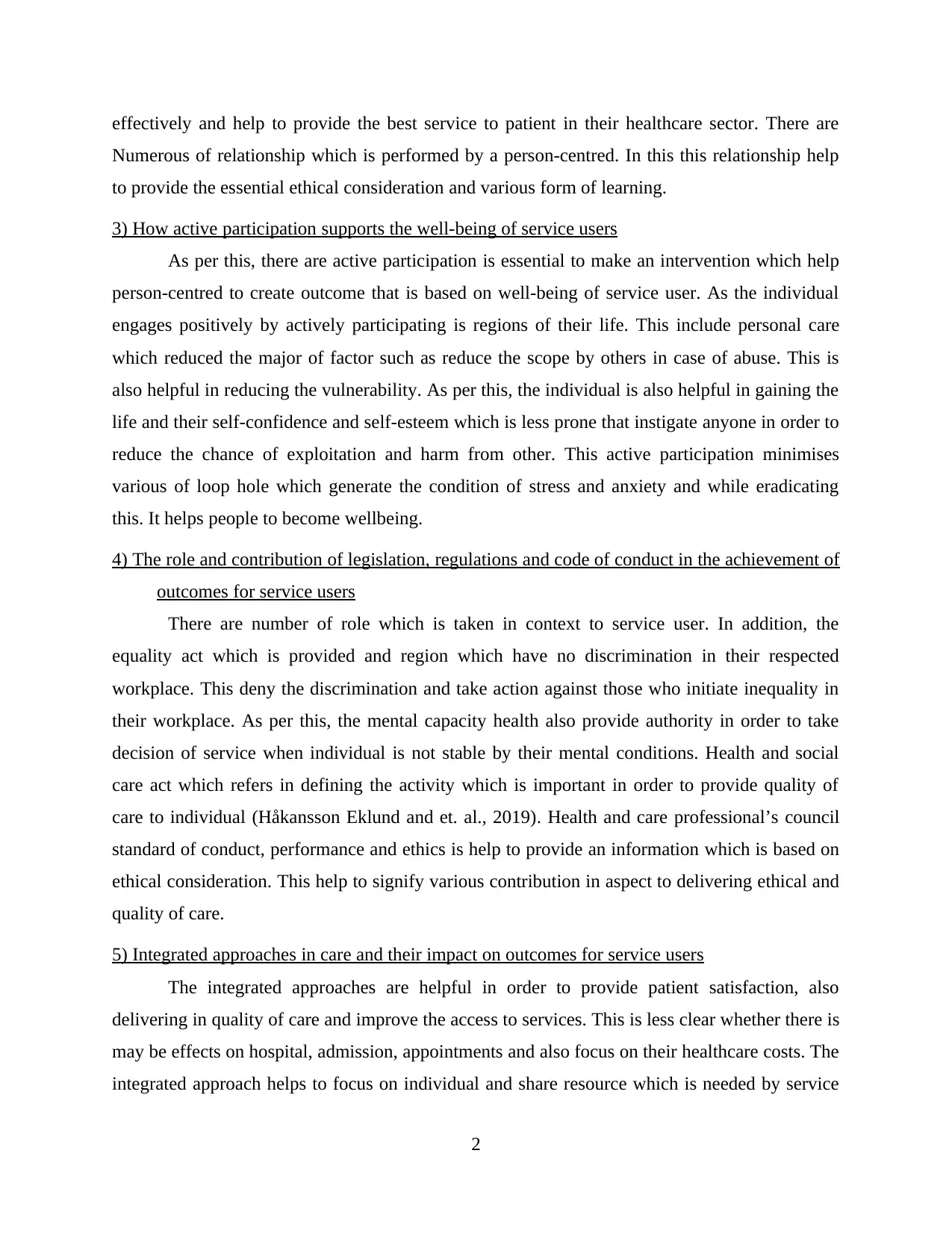
effectively and help to provide the best service to patient in their healthcare sector. There are
Numerous of relationship which is performed by a person-centred. In this this relationship help
to provide the essential ethical consideration and various form of learning.
3) How active participation supports the well-being of service users
As per this, there are active participation is essential to make an intervention which help
person-centred to create outcome that is based on well-being of service user. As the individual
engages positively by actively participating is regions of their life. This include personal care
which reduced the major of factor such as reduce the scope by others in case of abuse. This is
also helpful in reducing the vulnerability. As per this, the individual is also helpful in gaining the
life and their self-confidence and self-esteem which is less prone that instigate anyone in order to
reduce the chance of exploitation and harm from other. This active participation minimises
various of loop hole which generate the condition of stress and anxiety and while eradicating
this. It helps people to become wellbeing.
4) The role and contribution of legislation, regulations and code of conduct in the achievement of
outcomes for service users
There are number of role which is taken in context to service user. In addition, the
equality act which is provided and region which have no discrimination in their respected
workplace. This deny the discrimination and take action against those who initiate inequality in
their workplace. As per this, the mental capacity health also provide authority in order to take
decision of service when individual is not stable by their mental conditions. Health and social
care act which refers in defining the activity which is important in order to provide quality of
care to individual (Håkansson Eklund and et. al., 2019). Health and care professional’s council
standard of conduct, performance and ethics is help to provide an information which is based on
ethical consideration. This help to signify various contribution in aspect to delivering ethical and
quality of care.
5) Integrated approaches in care and their impact on outcomes for service users
The integrated approaches are helpful in order to provide patient satisfaction, also
delivering in quality of care and improve the access to services. This is less clear whether there is
may be effects on hospital, admission, appointments and also focus on their healthcare costs. The
integrated approach helps to focus on individual and share resource which is needed by service
2
Numerous of relationship which is performed by a person-centred. In this this relationship help
to provide the essential ethical consideration and various form of learning.
3) How active participation supports the well-being of service users
As per this, there are active participation is essential to make an intervention which help
person-centred to create outcome that is based on well-being of service user. As the individual
engages positively by actively participating is regions of their life. This include personal care
which reduced the major of factor such as reduce the scope by others in case of abuse. This is
also helpful in reducing the vulnerability. As per this, the individual is also helpful in gaining the
life and their self-confidence and self-esteem which is less prone that instigate anyone in order to
reduce the chance of exploitation and harm from other. This active participation minimises
various of loop hole which generate the condition of stress and anxiety and while eradicating
this. It helps people to become wellbeing.
4) The role and contribution of legislation, regulations and code of conduct in the achievement of
outcomes for service users
There are number of role which is taken in context to service user. In addition, the
equality act which is provided and region which have no discrimination in their respected
workplace. This deny the discrimination and take action against those who initiate inequality in
their workplace. As per this, the mental capacity health also provide authority in order to take
decision of service when individual is not stable by their mental conditions. Health and social
care act which refers in defining the activity which is important in order to provide quality of
care to individual (Håkansson Eklund and et. al., 2019). Health and care professional’s council
standard of conduct, performance and ethics is help to provide an information which is based on
ethical consideration. This help to signify various contribution in aspect to delivering ethical and
quality of care.
5) Integrated approaches in care and their impact on outcomes for service users
The integrated approaches are helpful in order to provide patient satisfaction, also
delivering in quality of care and improve the access to services. This is less clear whether there is
may be effects on hospital, admission, appointments and also focus on their healthcare costs. The
integrated approach helps to focus on individual and share resource which is needed by service
2
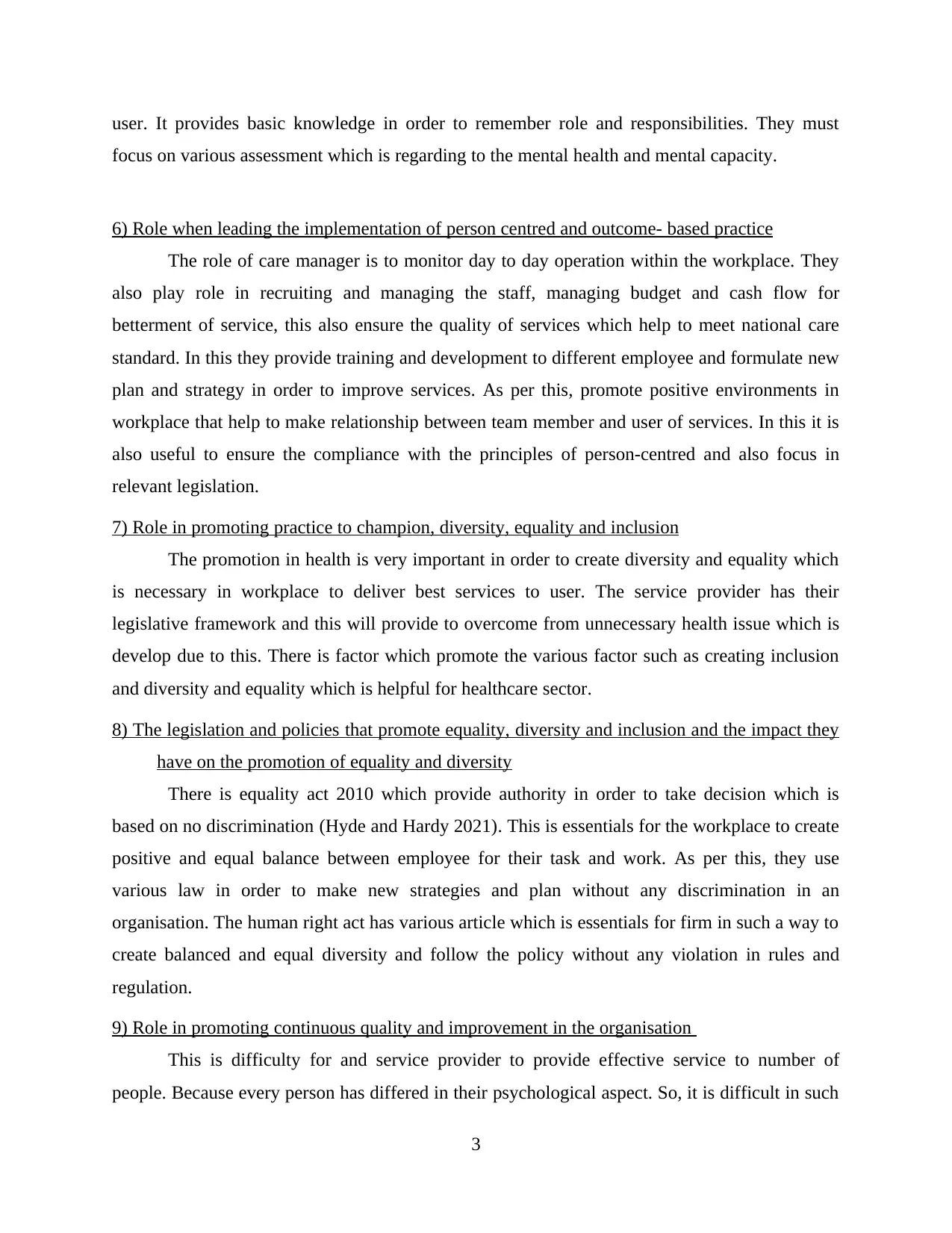
user. It provides basic knowledge in order to remember role and responsibilities. They must
focus on various assessment which is regarding to the mental health and mental capacity.
6) Role when leading the implementation of person centred and outcome- based practice
The role of care manager is to monitor day to day operation within the workplace. They
also play role in recruiting and managing the staff, managing budget and cash flow for
betterment of service, this also ensure the quality of services which help to meet national care
standard. In this they provide training and development to different employee and formulate new
plan and strategy in order to improve services. As per this, promote positive environments in
workplace that help to make relationship between team member and user of services. In this it is
also useful to ensure the compliance with the principles of person-centred and also focus in
relevant legislation.
7) Role in promoting practice to champion, diversity, equality and inclusion
The promotion in health is very important in order to create diversity and equality which
is necessary in workplace to deliver best services to user. The service provider has their
legislative framework and this will provide to overcome from unnecessary health issue which is
develop due to this. There is factor which promote the various factor such as creating inclusion
and diversity and equality which is helpful for healthcare sector.
8) The legislation and policies that promote equality, diversity and inclusion and the impact they
have on the promotion of equality and diversity
There is equality act 2010 which provide authority in order to take decision which is
based on no discrimination (Hyde and Hardy 2021). This is essentials for the workplace to create
positive and equal balance between employee for their task and work. As per this, they use
various law in order to make new strategies and plan without any discrimination in an
organisation. The human right act has various article which is essentials for firm in such a way to
create balanced and equal diversity and follow the policy without any violation in rules and
regulation.
9) Role in promoting continuous quality and improvement in the organisation
This is difficulty for and service provider to provide effective service to number of
people. Because every person has differed in their psychological aspect. So, it is difficult in such
3
focus on various assessment which is regarding to the mental health and mental capacity.
6) Role when leading the implementation of person centred and outcome- based practice
The role of care manager is to monitor day to day operation within the workplace. They
also play role in recruiting and managing the staff, managing budget and cash flow for
betterment of service, this also ensure the quality of services which help to meet national care
standard. In this they provide training and development to different employee and formulate new
plan and strategy in order to improve services. As per this, promote positive environments in
workplace that help to make relationship between team member and user of services. In this it is
also useful to ensure the compliance with the principles of person-centred and also focus in
relevant legislation.
7) Role in promoting practice to champion, diversity, equality and inclusion
The promotion in health is very important in order to create diversity and equality which
is necessary in workplace to deliver best services to user. The service provider has their
legislative framework and this will provide to overcome from unnecessary health issue which is
develop due to this. There is factor which promote the various factor such as creating inclusion
and diversity and equality which is helpful for healthcare sector.
8) The legislation and policies that promote equality, diversity and inclusion and the impact they
have on the promotion of equality and diversity
There is equality act 2010 which provide authority in order to take decision which is
based on no discrimination (Hyde and Hardy 2021). This is essentials for the workplace to create
positive and equal balance between employee for their task and work. As per this, they use
various law in order to make new strategies and plan without any discrimination in an
organisation. The human right act has various article which is essentials for firm in such a way to
create balanced and equal diversity and follow the policy without any violation in rules and
regulation.
9) Role in promoting continuous quality and improvement in the organisation
This is difficulty for and service provider to provide effective service to number of
people. Because every person has differed in their psychological aspect. So, it is difficult in such
3
⊘ This is a preview!⊘
Do you want full access?
Subscribe today to unlock all pages.

Trusted by 1+ million students worldwide
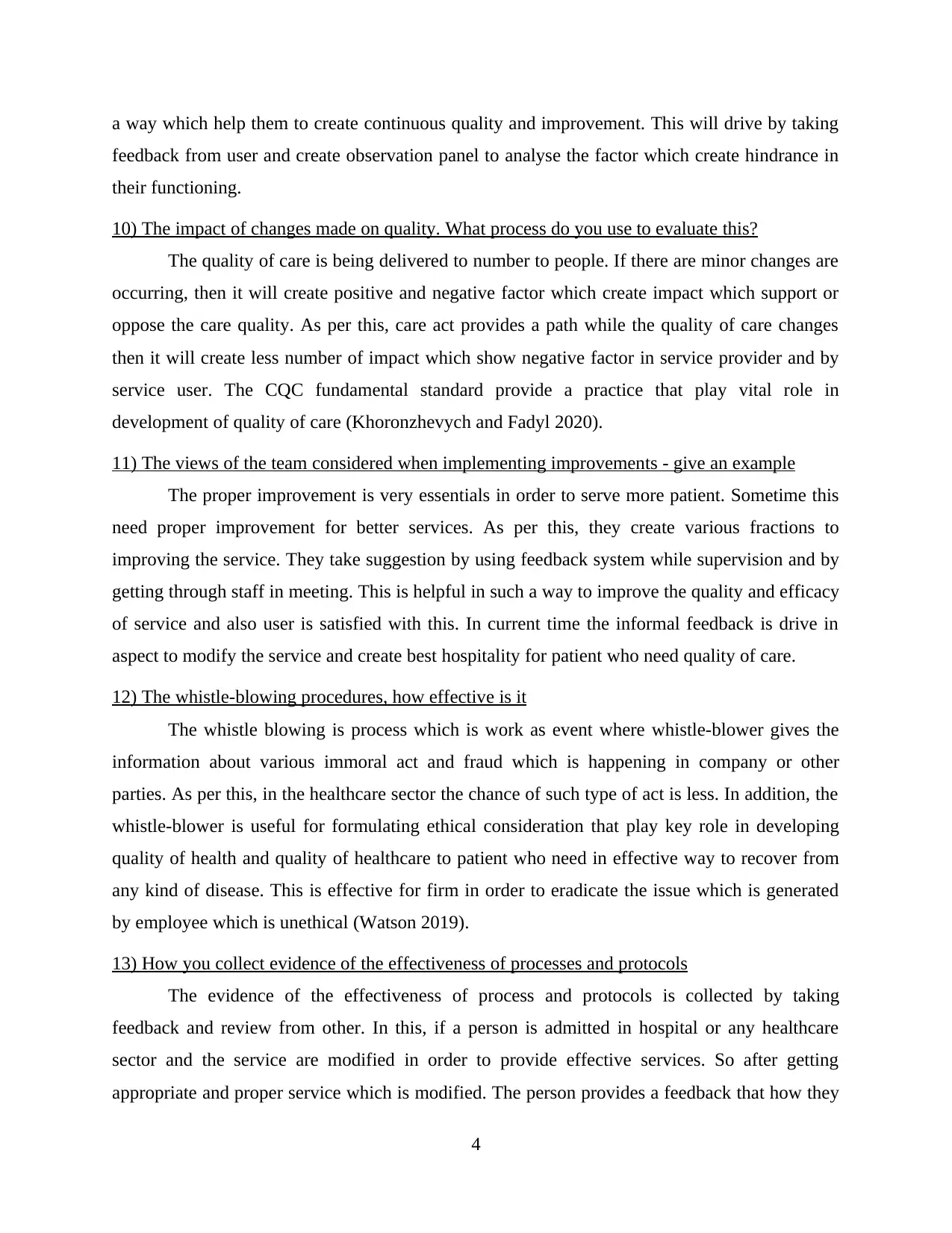
a way which help them to create continuous quality and improvement. This will drive by taking
feedback from user and create observation panel to analyse the factor which create hindrance in
their functioning.
10) The impact of changes made on quality. What process do you use to evaluate this?
The quality of care is being delivered to number to people. If there are minor changes are
occurring, then it will create positive and negative factor which create impact which support or
oppose the care quality. As per this, care act provides a path while the quality of care changes
then it will create less number of impact which show negative factor in service provider and by
service user. The CQC fundamental standard provide a practice that play vital role in
development of quality of care (Khoronzhevych and Fadyl 2020).
11) The views of the team considered when implementing improvements - give an example
The proper improvement is very essentials in order to serve more patient. Sometime this
need proper improvement for better services. As per this, they create various fractions to
improving the service. They take suggestion by using feedback system while supervision and by
getting through staff in meeting. This is helpful in such a way to improve the quality and efficacy
of service and also user is satisfied with this. In current time the informal feedback is drive in
aspect to modify the service and create best hospitality for patient who need quality of care.
12) The whistle-blowing procedures, how effective is it
The whistle blowing is process which is work as event where whistle-blower gives the
information about various immoral act and fraud which is happening in company or other
parties. As per this, in the healthcare sector the chance of such type of act is less. In addition, the
whistle-blower is useful for formulating ethical consideration that play key role in developing
quality of health and quality of healthcare to patient who need in effective way to recover from
any kind of disease. This is effective for firm in order to eradicate the issue which is generated
by employee which is unethical (Watson 2019).
13) How you collect evidence of the effectiveness of processes and protocols
The evidence of the effectiveness of process and protocols is collected by taking
feedback and review from other. In this, if a person is admitted in hospital or any healthcare
sector and the service are modified in order to provide effective services. So after getting
appropriate and proper service which is modified. The person provides a feedback that how they
4
feedback from user and create observation panel to analyse the factor which create hindrance in
their functioning.
10) The impact of changes made on quality. What process do you use to evaluate this?
The quality of care is being delivered to number to people. If there are minor changes are
occurring, then it will create positive and negative factor which create impact which support or
oppose the care quality. As per this, care act provides a path while the quality of care changes
then it will create less number of impact which show negative factor in service provider and by
service user. The CQC fundamental standard provide a practice that play vital role in
development of quality of care (Khoronzhevych and Fadyl 2020).
11) The views of the team considered when implementing improvements - give an example
The proper improvement is very essentials in order to serve more patient. Sometime this
need proper improvement for better services. As per this, they create various fractions to
improving the service. They take suggestion by using feedback system while supervision and by
getting through staff in meeting. This is helpful in such a way to improve the quality and efficacy
of service and also user is satisfied with this. In current time the informal feedback is drive in
aspect to modify the service and create best hospitality for patient who need quality of care.
12) The whistle-blowing procedures, how effective is it
The whistle blowing is process which is work as event where whistle-blower gives the
information about various immoral act and fraud which is happening in company or other
parties. As per this, in the healthcare sector the chance of such type of act is less. In addition, the
whistle-blower is useful for formulating ethical consideration that play key role in developing
quality of health and quality of healthcare to patient who need in effective way to recover from
any kind of disease. This is effective for firm in order to eradicate the issue which is generated
by employee which is unethical (Watson 2019).
13) How you collect evidence of the effectiveness of processes and protocols
The evidence of the effectiveness of process and protocols is collected by taking
feedback and review from other. In this, if a person is admitted in hospital or any healthcare
sector and the service are modified in order to provide effective services. So after getting
appropriate and proper service which is modified. The person provides a feedback that how they
4
Paraphrase This Document
Need a fresh take? Get an instant paraphrase of this document with our AI Paraphraser
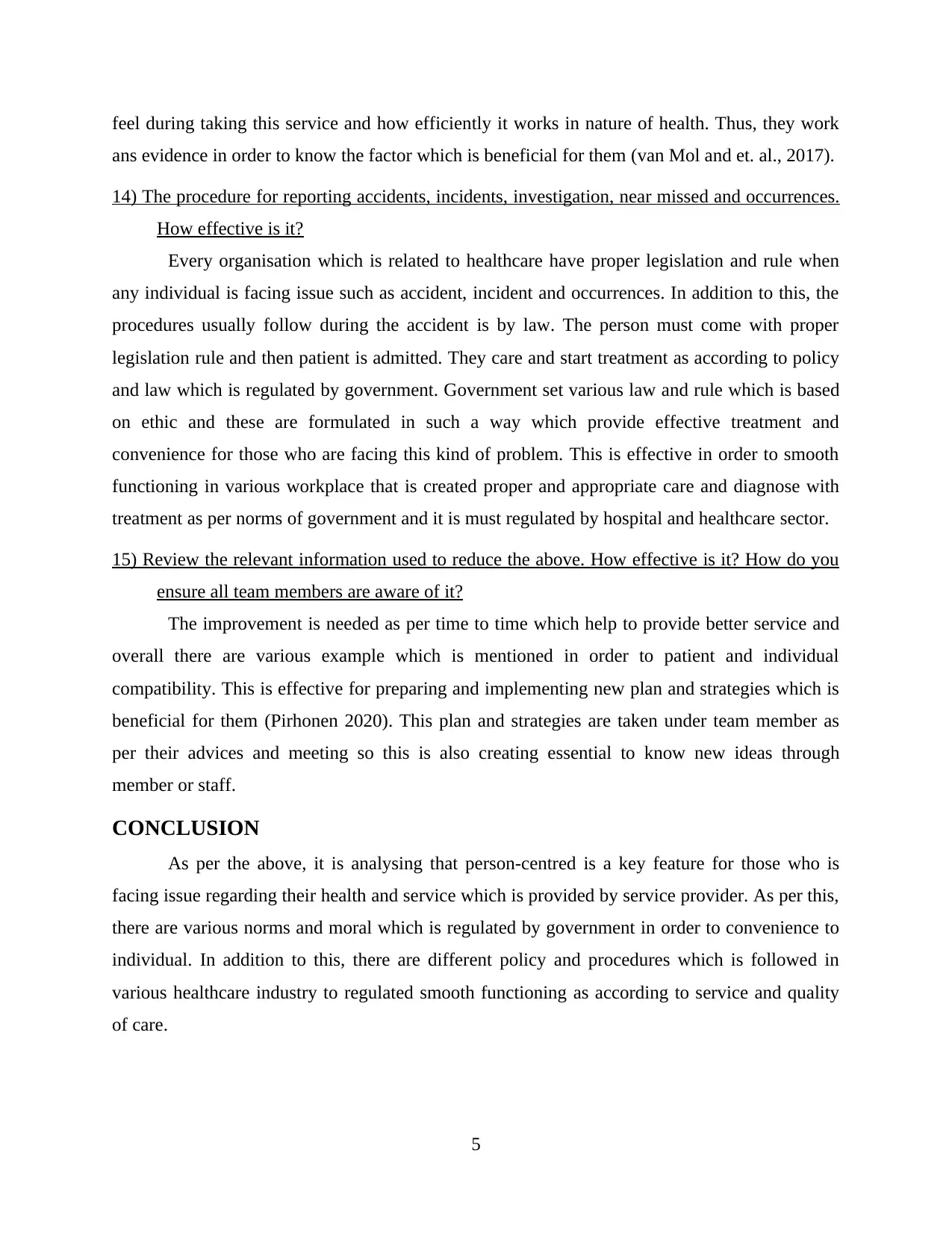
feel during taking this service and how efficiently it works in nature of health. Thus, they work
ans evidence in order to know the factor which is beneficial for them (van Mol and et. al., 2017).
14) The procedure for reporting accidents, incidents, investigation, near missed and occurrences.
How effective is it?
Every organisation which is related to healthcare have proper legislation and rule when
any individual is facing issue such as accident, incident and occurrences. In addition to this, the
procedures usually follow during the accident is by law. The person must come with proper
legislation rule and then patient is admitted. They care and start treatment as according to policy
and law which is regulated by government. Government set various law and rule which is based
on ethic and these are formulated in such a way which provide effective treatment and
convenience for those who are facing this kind of problem. This is effective in order to smooth
functioning in various workplace that is created proper and appropriate care and diagnose with
treatment as per norms of government and it is must regulated by hospital and healthcare sector.
15) Review the relevant information used to reduce the above. How effective is it? How do you
ensure all team members are aware of it?
The improvement is needed as per time to time which help to provide better service and
overall there are various example which is mentioned in order to patient and individual
compatibility. This is effective for preparing and implementing new plan and strategies which is
beneficial for them (Pirhonen 2020). This plan and strategies are taken under team member as
per their advices and meeting so this is also creating essential to know new ideas through
member or staff.
CONCLUSION
As per the above, it is analysing that person-centred is a key feature for those who is
facing issue regarding their health and service which is provided by service provider. As per this,
there are various norms and moral which is regulated by government in order to convenience to
individual. In addition to this, there are different policy and procedures which is followed in
various healthcare industry to regulated smooth functioning as according to service and quality
of care.
5
ans evidence in order to know the factor which is beneficial for them (van Mol and et. al., 2017).
14) The procedure for reporting accidents, incidents, investigation, near missed and occurrences.
How effective is it?
Every organisation which is related to healthcare have proper legislation and rule when
any individual is facing issue such as accident, incident and occurrences. In addition to this, the
procedures usually follow during the accident is by law. The person must come with proper
legislation rule and then patient is admitted. They care and start treatment as according to policy
and law which is regulated by government. Government set various law and rule which is based
on ethic and these are formulated in such a way which provide effective treatment and
convenience for those who are facing this kind of problem. This is effective in order to smooth
functioning in various workplace that is created proper and appropriate care and diagnose with
treatment as per norms of government and it is must regulated by hospital and healthcare sector.
15) Review the relevant information used to reduce the above. How effective is it? How do you
ensure all team members are aware of it?
The improvement is needed as per time to time which help to provide better service and
overall there are various example which is mentioned in order to patient and individual
compatibility. This is effective for preparing and implementing new plan and strategies which is
beneficial for them (Pirhonen 2020). This plan and strategies are taken under team member as
per their advices and meeting so this is also creating essential to know new ideas through
member or staff.
CONCLUSION
As per the above, it is analysing that person-centred is a key feature for those who is
facing issue regarding their health and service which is provided by service provider. As per this,
there are various norms and moral which is regulated by government in order to convenience to
individual. In addition to this, there are different policy and procedures which is followed in
various healthcare industry to regulated smooth functioning as according to service and quality
of care.
5
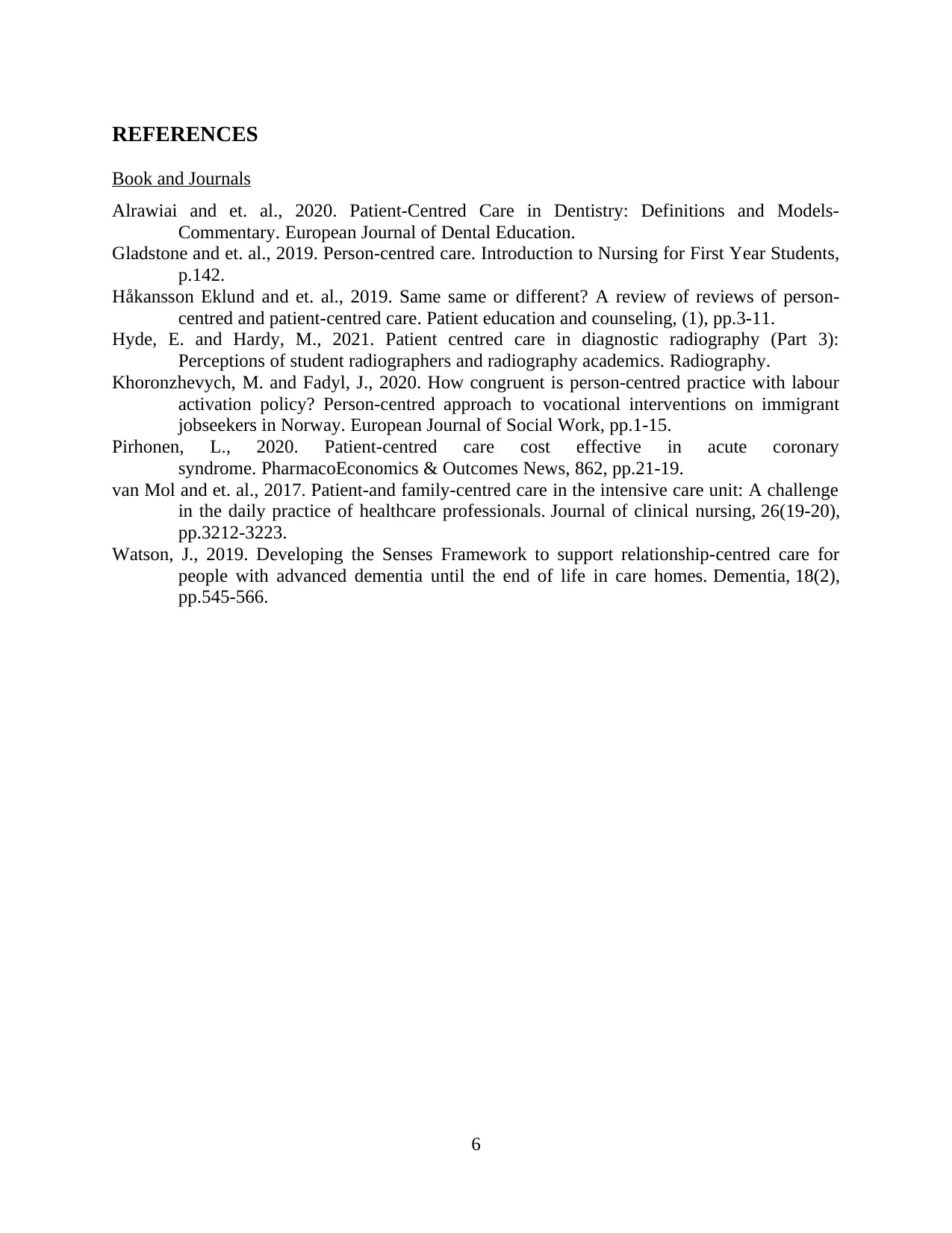
REFERENCES
Book and Journals
Alrawiai and et. al., 2020. Patient‐Centred Care in Dentistry: Definitions and Models‐
Commentary. European Journal of Dental Education.
Gladstone and et. al., 2019. Person-centred care. Introduction to Nursing for First Year Students,
p.142.
Håkansson Eklund and et. al., 2019. Same same or different? A review of reviews of person-
centred and patient-centred care. Patient education and counseling, (1), pp.3-11.
Hyde, E. and Hardy, M., 2021. Patient centred care in diagnostic radiography (Part 3):
Perceptions of student radiographers and radiography academics. Radiography.
Khoronzhevych, M. and Fadyl, J., 2020. How congruent is person-centred practice with labour
activation policy? Person-centred approach to vocational interventions on immigrant
jobseekers in Norway. European Journal of Social Work, pp.1-15.
Pirhonen, L., 2020. Patient-centred care cost effective in acute coronary
syndrome. PharmacoEconomics & Outcomes News, 862, pp.21-19.
van Mol and et. al., 2017. Patient‐and family‐centred care in the intensive care unit: A challenge
in the daily practice of healthcare professionals. Journal of clinical nursing, 26(19-20),
pp.3212-3223.
Watson, J., 2019. Developing the Senses Framework to support relationship-centred care for
people with advanced dementia until the end of life in care homes. Dementia, 18(2),
pp.545-566.
6
Book and Journals
Alrawiai and et. al., 2020. Patient‐Centred Care in Dentistry: Definitions and Models‐
Commentary. European Journal of Dental Education.
Gladstone and et. al., 2019. Person-centred care. Introduction to Nursing for First Year Students,
p.142.
Håkansson Eklund and et. al., 2019. Same same or different? A review of reviews of person-
centred and patient-centred care. Patient education and counseling, (1), pp.3-11.
Hyde, E. and Hardy, M., 2021. Patient centred care in diagnostic radiography (Part 3):
Perceptions of student radiographers and radiography academics. Radiography.
Khoronzhevych, M. and Fadyl, J., 2020. How congruent is person-centred practice with labour
activation policy? Person-centred approach to vocational interventions on immigrant
jobseekers in Norway. European Journal of Social Work, pp.1-15.
Pirhonen, L., 2020. Patient-centred care cost effective in acute coronary
syndrome. PharmacoEconomics & Outcomes News, 862, pp.21-19.
van Mol and et. al., 2017. Patient‐and family‐centred care in the intensive care unit: A challenge
in the daily practice of healthcare professionals. Journal of clinical nursing, 26(19-20),
pp.3212-3223.
Watson, J., 2019. Developing the Senses Framework to support relationship-centred care for
people with advanced dementia until the end of life in care homes. Dementia, 18(2),
pp.545-566.
6
⊘ This is a preview!⊘
Do you want full access?
Subscribe today to unlock all pages.

Trusted by 1+ million students worldwide
1 out of 9
Related Documents
Your All-in-One AI-Powered Toolkit for Academic Success.
+13062052269
info@desklib.com
Available 24*7 on WhatsApp / Email
![[object Object]](/_next/static/media/star-bottom.7253800d.svg)
Unlock your academic potential
Copyright © 2020–2025 A2Z Services. All Rights Reserved. Developed and managed by ZUCOL.




